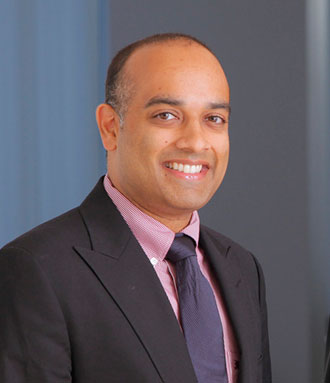
Dr. Rohan Ramakrishna, the Alvina and Willis Murphy Assistant Professor of Neurological Surgery, will lead Weill Cornell Medicine’s neurosurgical efforts within a new multi-disciplinary, inter-campus center focused on glioblastoma multiforme (GBM). The new William Rhodes and Louise Tilzer-Rhodes Center for Glioblastoma is being made possible by an initial $5 million gift to NewYork-Presbyterian Hospital from William Rhodes. Mr. Rhodes made the gift in memory of his wife, Louise Tilzer-Rhodes, who lost her battle with GBM in 2016.
“I’m delighted to have Dr. Ramakrishna leading the neurosurgical arm of this effort for Weill Cornell Medicine,” says Dr. Philip E. Stieg, professor and chairman of the Weill Cornell Medicine Brain and Spine Center and Neurosurgeon-in-Chief of NewYork-Presbyterian/Weill Cornell Medical Center. “This is an amazing time in brain tumor research, with the science advancing at an extremely rapid pace and new opportunities for translation research and clinical trials opening up on practically an everyday basis.”
The GBM center will concentrate its efforts on innovative translational research to bring new treatment options to patients diagnosed with glioblastoma, one of the deadliest of brain tumors. Dr. Ramakrishna, who is currently offering two viral therapy-based clinical trials for brain tumors and who directs the new Brain Metastases Program at the Weill Cornell Medicine Brain and Spine Center, will work with Dr. Howard Fine, director of the Brain Tumor Center at NewYork-Presbyterian/Weill Cornell Medical Center; Dr. Jeffrey Bruce, co-director of the Brain Tumor Center at NewYork-Presbyterian/Columbia University Medical Center; and Dr. Andrew Lassman, chief of the division of neuro-oncology in the Department of Neurology and co-director of the Brain Tumor Center at NewYork-Presbyterian/Columbia University Medical Center.
“I'm honored to be a part of this new center, which promises to accelerate new treatments for GBM patients,” says Dr. Ramakrishna. “All four departments are already moving quickly on immunotherapy, viral therapies, and other innovative approaches. By combining our efforts into one center, we are bound to make more progress, and faster, than any of us could accomplish alone.”